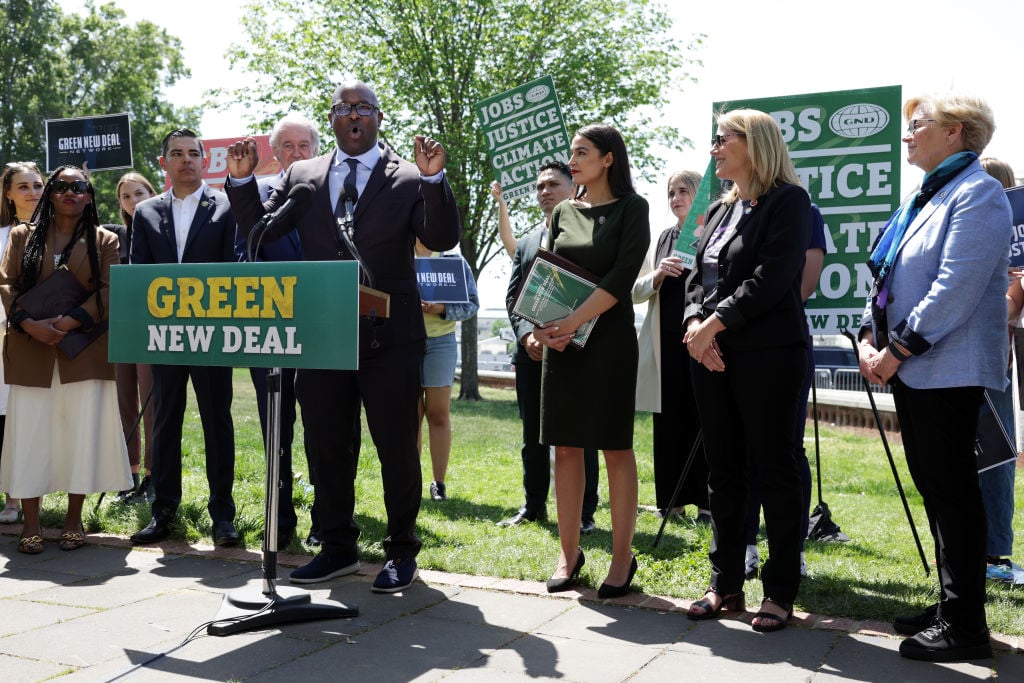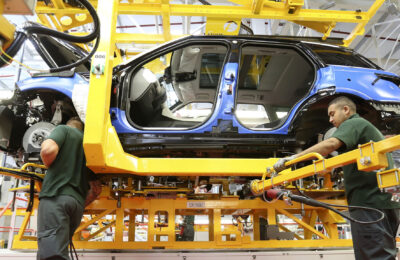From Truth Out– a contribution to the ongoing debate around growth
Degrowth and its opponents recognize the necessity of mass movements and system change to address the climate emergency.

Degrowth, a movement advocating reductions in energy and resource use across the Global North, is finding new audiences. In Japan, Kohei Saito’s degrowth manifesto Capital in the Anthropocene became a bestseller. In Europe, members of the European Parliament sponsored a three-day “Beyond Growth” conference. In the U.S., the socialist journal Monthly Review has come around to degrowth. In recent weeks, the topic has been covered by New Statesman, The New Yorker, Jacobin, the British Medical Journal and The New York Times, among others.
Writing in New Statesman, economist Hans Stegeman proposes that the debates between degrowth and green growth are already outdated. In the present era of low GDP growth, there is no meaningful choice between the two. Instead, at least in the absence of any radical reordering of society, economies are by default transitioning toward a post-growth model.
In The New Yorker, environmental activist Bill McKibben presents degrowth as a call to reduce consumption, in contrast to the Green New Deal (GND), which emphasizes production. Evenhandedly, he opposes “endless” growth but parts company with degrowthers when they, citing the ecological costs of all the mining required, refuse to support “an all-out push for electric vehicles (EVs), heat pumps, solar panels and wind turbines.” Why not do both, he asks: Invest in renewables and EVs while also restricting “wasteful consumerism”?
Jacobin is where we find the most vinegary views, adverted already in the title: “The Problem With Degrowth.” Matt Huber, a Syracuse professor whose Climate Change as Class War appeared last year, finds a few polite words for degrowthers’ critique of capitalism but rejects the rest. For Huber, degrowth is a politics of austerity. It is anti-Marxist — where Marxism is portrayed (idiosyncratically) as a program for the state-led ramping up of production and consumption. Scornful of degrowthers’ “prohibition” on technological development and their insistence on constraining energy use and material throughput, his counterproposal centers on the “massive development of the productive forces.” And whereas degrowthers perceive the transgressing of planetary boundaries as an existential threat, Huber’s stance is laid back. One of them, the ozone hole, has already been “fixed,” and so splendidly simply, with a change of technology. All the other eight — of which climate change and biodiversity disappearance are but two — can be fixed by “qualitative transformations of specific sectors of production.”
To “fix” climate change, the specific sector to be transformed is energy. For the U.S., Huber borrows “prominent modeling” from Princeton’s Net-Zero America report to advocate massive investment in heat pumps and renewable energy, in carbon capture and storage (CCS), and in construction of 250 “large” nuclear reactors. He sees the Princeton program as compatible with an electorally popular GND, which he contrasts with degrowth’s lack of voter support. This last critique carries a hint of projection, given that Huber’s own manifesto, the nationalization of all private companies under a socialist planning regime, is hardly riding high in the polls. All the world-transforming causes have had to be fought for, initially against the majority tide.
Getting Clear About What Degrowth Really Means
These recent appraisals of degrowth range from friendly to frosty, but they each include misrepresentations.
First off, degrowthers emphatically do not advocate recession or austerity. These flow from the dynamics of capital accumulation that they critique, abhor and seek to overcome. Drawing on socialist, anarchist, decolonial and feminist traditions, their project is societal transformation with radical redistribution, domestically and internationally, to raise living standards for the masses.
Secondly, the distinction between degrowth and the GND cannot be mapped to simple binaries, whether “reduce consumption vs. invest in production,” “reject vs. promote new tech” or “individual sacrifice vs. collective action.” Many opponents of degrowth maintain that electricity should be a human right and available to all the world’s population; most degrowthers would agree. They advocate gargantuan investments in energy-efficiency technologies and renewables. Degrowther Jason Hickel, for example, calls for public investment to be targeted to churning out solar panels, heat pumps and batteries “at a historically unprecedented rate, reminiscent of the industrial retooling that enabled the allies to win the second world war.” A vital actor in pushing for such a program will be organized labor, and this too is recognized by degrowthers. They see powerful unions as essential allies. Workers, after all, are not wedded to endless GDP growth. Rather, their needs are human: security of life and livelihood, opportunities to flourish, respect, community, hope and, above all, a habitable planet.
In short, there is no necessary opposition between degrowth and a GND. Degrowthers do, however, raise caveats surrounding the material implications of expansionary programs — particularly if the whole world shares in them, as it should. While supporting the renewables rollout, they scrutinize its material requirements — in land, for example, or in the coal-powered electricity used to produce much of the clean energy infrastructure. And where McKibben calls for an “all-out push” for EVs, degrowthers warn of the consequences if U.S. car ownership were replicated worldwide: the tonnage of steel, plastic, lithium etc. on the world’s roads would leap by 500 percent, schlepped around in the form of 7 billion automobiles.
What could replace the bulk of cars in a degrowth (or “degrowth-GND”) future? Bicycles and public transport: buses, coaches, rail. These, for degrowthers and many Green New Dealers, ought to be free of charge. On high-speed rail, Green New Dealers such as Huber and Bernie Sanders are vocal supporters, and many degrowthers are too — but again, with caveats. To construct new track, colossal quantities of concrete are poured, each ton releasing an equivalent tonnage of carbon dioxide (CO2). As a source of carbon emissions, only coal, oil and gas are worse, and while low-carbon concrete is beginning to come on stream, it’s expensive and will take years to scale up. England’s “HS2” project is widely, and now even officially, seen as “unachievable,” a costly flop. China, by contrast, proves that high-speed rail rollout can be quick and successful in its own terms. Yet it arrived together with an equally rapid expansion of road transport and aviation that eclipsed any environmental benefits of rail.
Captured by Carbon
On all aspects of decarbonization, areas of agreement exist between degrowth and the GND, as well as divisions within each camp. Consider the trickiest industry to decarbonize: aviation.
Some GND proposals, such as the Green New Deal for Gatwick (Britain’s second airport), are compatible with degrowth; they center on the retraining of aviation workers in non-polluting industries. Huber, by contrast, defends aviation, reserving scorn and mockery for those who believe that many airline passengers bear some responsibility for the exhaust gases from the jet fuel for which they’ve paid.
The average American takes between two and three trips by plane each year — for, while 50-60 percent of Americans don’t fly at all in any given year, frequent flyers bring the average up. For Global South citizens, the figure is between zero and one. Given that no sustainable fuel exists that could replace kerosene in sufficient volume in the next 20 years at least, were the American way of life to be globalized, its emissions would send global heating off the charts.
Aviation, from this angle, exemplifies the title of Huber’s book, Climate Change as Class War, for it is highly polluting and largely consumed by the rich. But Huber does not read it in this way. He tends to defend aviation, claiming that it contributes only 2.5 percent of global emissions — presumably unaware that this figure is industry propaganda. Aviation’s overall contribution to global heating is in fact far greater; many researchers believe by a factor of three.
Huber frames his defense of aviation in terms of the “material interests” of U.S. workers, within a class analysis that sets capitalists and workers at opposite poles, with middle classes in between, including a “professional-managerial class” (PMC) of scientists, tenured professors, lawyers and the like. Many within this layer, and certainly those on six-figure salaries, belong to the richest 1 percent of the global population, a group that is responsible for fully half of aviation emissions, with the average North American flying twice as far as the European and 50 times as far as the average African. In this light, Huber’s aviation apologia risks appearing as a defense of the status and short-term consumption interests of the world’s top 1 percent, in defiance of the long-term survival interests of the world’s workers.
Digging a little further, we find that the decarbonization program championed by some anti-degrowth opponents is borrowed wholesale from BP and ExxonMobil. They are the funders of Princeton’s Carbon Mitigation Initiative and of the Net-Zero America study on which Huber bases his decarbonization program. The “prominence” that caught his eye was furnished by dirty money. According to internal documents available to DeSmog reporters, BP and the other oil giants identified carbon capture as the most persuasive ruse to ensure they can drill and pump ad infinitum. For BP, the strategy has been to leverage “academic partnerships, including Princeton’s Carbon Mitigation Initiative, which the company has directly funded and sponsored since its inception in 2000.” The process works to perfection. Following the example of the tobacco industry, Big Oil invests in “research” by its tools in academia; the latter gain kudos from participating in lavishly funded projects; this greases their promotion to the top of the professorial tree, from which perch they trill hymns to carbon capture.
What the Princeton models are designed to occlude is that CCS is a reckless gamble on a speculative technology. In most countries, CCS is unregulated. Worldwide, the only plants for carbon sequestration are expensive, tiny, unproven at scale, failing to meet targets and potentially dangerous. A recent report on Norway’s Sleipner and Snøhvit pilot plants revealed unexpected behavior of CO2 in even the most intensively studied of aquifers, a reminder that the danger of leakage is all too real. The lobby power behind CCS are the oil giants but also coal. In May this year, the National Mining Association called for a “carbon capture moonshot.” This is the fossil-industrial attempt to hijack and delay the decarbonization agenda.
Notable, too, in the Princeton models, is that not all include nuclear power, but the one that does proposes reaching net zero in the U.S. using CCS (of course, it’s the Exxon-Princeton game plan) combined with a quadrupling of the number of “large” nuclear plants. Some may assume this is reasonable, but again, look at the small print. Much power would remain fossil fueled, and only the U.S. is considered. If the current U.S. level of per capita energy consumption were rolled out worldwide and powered by nuclear plants, these would have to be multiplied 88-fold. To visualize that, take the current number worldwide, 440, and raise it to 38,720 — and then, if your model requires GDP growth, hike it further. Even if you prefer nuclear to supply only, say, one-quarter of the world’s energy, that would still require an increase from several hundred to nearly 10,000 nuclear power stations. Considering, in addition, that nuclear is the most expensive source of power, any plan promoting it appears myopic — and that’s even before we get to the radioactive waste, in cans being endlessly kicked down the road.
Degrowth and Consumption
To paraphrase German philosopher Max Horkheimer, whoever is not prepared to talk about capitalism should also remain silent about climate change. But what does that mean? Huber argues that climate change is “produced [by the] small minority of capitalists who own and control the means of production.” Other Marxists and most degrowthers would concur — up to a point. As the oft-memed quote has it, “The Earth isn’t dying, it’s being killed, and those who are killing it have names and addresses.”
Those names, described in a recent CNN report as the “super-emitters,” comprise a sliver of the global 1 percent — the tycoons, moguls, bankers and presidents. Their capital structures society, enforcing its familiar mode of production. However, capital relations also configure modes of social reproduction and consumption. Capitalism’s mode of consumption manifests as a realm of leisure time and individual free choice (set against the realm of production), differentiated along steep hierarchies of income, and with workers’ consumption dialed down to ensure buoyant profits. With economic growth, consumption tends upward, and this expresses simultaneously as an expansion of human needs and their “manufacture” by capital in its interests. Capital accumulation requires a mode of consumption geared to the endless development of new consumption opportunities.
Take the case of aviation. Fifty years ago, only the rich took flights. Now, thanks to scale economies, aviation workers’ pay repression and cheap flights, a section of workers in the Global North can afford to fly. In one sense, it’s a triumph of social democracy: The world is now accessible to us too! The elite, meanwhile, move up a level, to private jets, which may in coming decades become a new social-democratic goal albeit in diluted version: Flying taxis for all!
Common Ground
To untangle the discussion around degrowth and consumption, it helps to recall the 1980s. It was the breakthrough decade of both the green movement and neoliberalism. For the latter, individuals define their identities through consumption choices in free markets. This ethos exerted a pull on the left. A consumption-oriented environmentalism arose; its strategy exaggerated the role of consumers in general, played to those who have money with which to “exercise choice,” and aligned with corporate PR campaigns that for decades had been pushing the message that individual consumers, not corporations or states, are responsible for the environmental crisis.
Yet the 1980s was also the breakout decade for the recognition that greenhouse gas emissions portend real peril. This helped to fuel a degrowth critique of capitalism’s mode of consumption — an indispensable adjunct to any critique of its mode of production. Their approach is not a liberal consumption ethic. It opposes consumerism tout court, especially where it is directly harmful: cigarettes, fossil fuels.
Before the dangers of global heating and biodiversity loss became widely known, such forms of consumption as eating beef or flying to Qatar to watch a ball being kicked around in air-conditioned stadia seemed relatively innocuous. In the age of climate breakdown, they no longer do. The knowledge that over two-thirds of deforestation is attributable to animal feed and cattle agriculture, and that each flight to the World Cup released one or two tons of carbon dioxide per passenger into the atmosphere where it’ll float around causing mayhem for many hundreds of years, sharply alters the ethical calculus.
How, then, to tackle what McKibben calls “wasteful consumerism”? Can the combination of factors — scientific education, campaigning, peer pressure and governmental “nudges” — that persuaded millions to quit smoking convince even greater numbers to quit beef and SUVs, and to watch their local team rather than fly to matches elsewhere? Big Oil, agribusiness and the aviation industry have followed Big Tobacco’s playbook and are lobbying hard to prevent that outcome. And because the infrastructure of our lives is far more reliant on fossil fuels than is a smoker’s on tobacco, incomparably greater force will be required. That means mass movements and system change. A world of radical democracy and equality — of “public luxury and private sufficiency,” with much less hierarchy and much more free time — would enable historic advances in the quality of life for the masses even if some consumer goods disappear from the menu. In that vision, degrowthers and Green New Dealers can find common ground.



